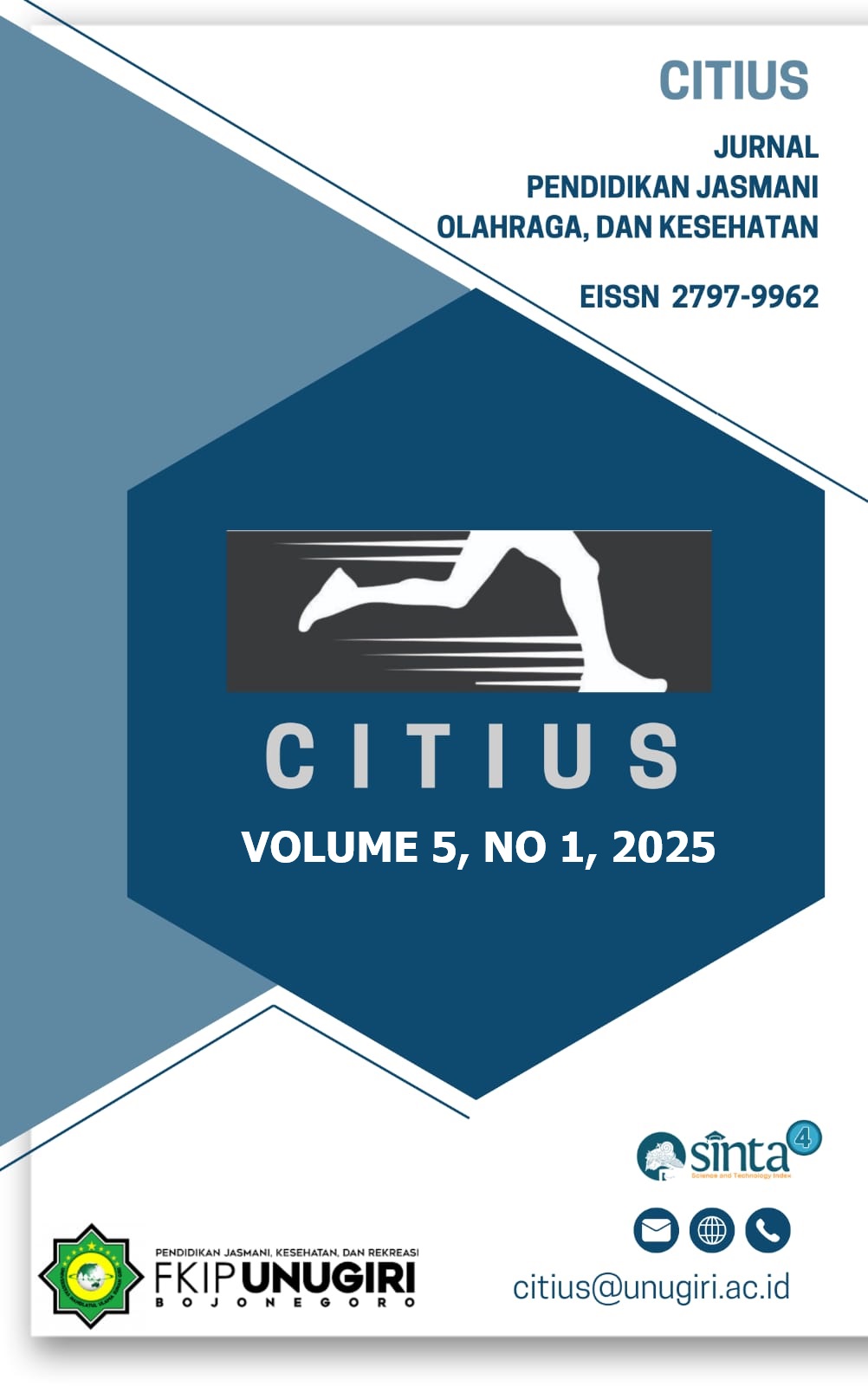Hot seat strategy to improve spike accuracy, confidence and motivation in volleyball learning
 PDF Download: 108
SIMILARITY CHECK Download: 60
PDF Download: 108
SIMILARITY CHECK Download: 60
DOI:
https://doi.org/10.32665/citius.v5i1.4129Keywords:
hot seat strategy, spike accuracy, confidence, active learning, volleyballAbstract
This study aims to analyze the effect of using the "Hot Seat" teaching strategy in improving the accuracy of high school students in volleyball spiking skills. This study also highlights how the strategy plays a role in improving students' self-confidence and motivation, in line with the increasing attention to the importance of active learning engagement in physical education. The main objectives of this study were to assess the effectiveness of the "Hot Seat" strategy in improving the accuracy of volleyball spiking performance and building students' self-confidence and evaluate its effect on motivation to achieve. The research method used an experimental design. The study sample consisted of 40 students who were randomly divided into two groups, and the data were analyzed using SPSS software to compare the results between groups. The results showed that the experimental group experienced significant improvements in all measured variables, including spike accuracy, self-confidence, and achievement motivation, when compared to the control group. The interactive "Hot Seat" strategy was shown to encourage critical thinking and active learning, resulting in deeper understanding and significant improvements in skill performance. Conclusion, the "Hot Seat" approach is an effective strategy in improving technical performance as well as psychological attributes of students in the process of learning sports education, and is able to transform students from passive recipients of information into active learners.
References
Agustini Raaiyatini, M., Basuki, S., Mashud, M., Pebriyandi, P., & Ridha, S. (2024). Improving Volleyball Lower Passing Skills Through Project-Based Learning Model. Indonesian Journal of Physical Education and Sport Science, 4(1 SE-), 76–89. https://doi.org/10.52188/ijpess.v4i1.583
Aliriad, H. (2023). The Effect of Project-Based on Fundamental Motor Skills to Enhance Early Children. Health Education and Health Promotion, 11(1).
Asrori, I. (2021). The application of digital storytelling in teaching speaking. In Dialectical Literature and Educational Journal (Vol. 5, Issue 2, pp. 77–83). Panca Sakti University, Bekasi. https://doi.org/10.51714/dlejpancasakti.v5i2.31.pp.77-83
Baena-Raya, A. (2021). The force-velocity profile as a determinant of spike and serve ball speed in top-level male volleyball players. PLOS ONE, 16(4). https://doi.org/10.1371/journal.pone.0249612
Castro, H. de O. (2022). Small-sided games in volleyball: A systematic review of the state of the art. In Biology of Sport (Vol. 39, Issue 4, pp. 995–1010). https://doi.org/10.5114/biolsport.2022.109960
Cheung, W.C., Ostrosky, M.M., Favazza, P.C., Stalega, M., & Yang, H.-W. (2022). Exploring the Perspectives of Preschool Teachers on Implementing Structured Motor Programs in Inclusive Classrooms. Early Childhood Education Journal, 51(2), 361–370. https://doi.org/10.1007/s10643-021-01295-x
Esminarto, E., Sukowati, S., Suryowati, N., & Anam, K. (2016). Implementation of the STAD model in improving student learning outcomes. BRILIANT: Research and Conceptual Journal, 1(1), 16–23. https://doi.org/https://doi.org/10.28926/briliant.v1i1.2
Giatsis, G. (2022). Spike Arm Swing Techniques of Olympics Male and Female Elite Volleyball Players (1984-2021). Journal of Sports Science and Medicine, 21(3), 465–472. https://doi.org/10.52082/jssm.2022.465
Iorfino, F., Varidel, M., Capon, W., Richards, M., Crouse, J. J., LaMonica, H. M., Park, S. H., Piper, S., Song, Y. J. C., Gorban, C., Scott, E. M., & Hickie, I. B. (2024). Quantifying the interrelationships between physical, social, and cognitive-emotional components of mental fitness using digital technology. In Npj mental health research (Vol. 3, Issue 1, p. 36). https://doi.org/10.1038/s44184-024-00078-7
Krzysztofik, M., Kalinowski, R., Filip-Stachnik, A., Wilk, M., & Zajac, A. (2021). The Effects of Plyometric Conditioning Exercises on Volleyball Performance with Self-Selected Rest Intervals. In Applied Sciences (Vol. 11, Issue 18, p. 8329). MDPI AG. https://doi.org/10.3390/app11188329
Kurniawati, A. (2023). Implementation of Discovery Learning Model on the Learning Motivation of Sixth Grade Students. In TEGAR: Journal of Teaching Physical Education in Elementary School (Vol. 6, Issue 2, pp. 57–72). Indonesian University of Education (UPI). https://doi.org/10.17509/tegar.v6i1.51033
Liu, S., & Li, Y. (2024). Influencing Factors and Training Strategies for Boulder and Lead Athletes' Competitive Performance: A Narrative Review. In Strength & Conditioning Journal. Ovid Technologies (Wolters Kluwer Health). https://doi.org/10.1519/ssc.0000000000000857
Muslimin, Asmawi, M., & Samsudin. (2020). The effect of service exercise with stage distance on service results in ball game volleyball. Jipes - journal of Indonesian physical education and sport, 5(02), 67–76. https://doi.org/10.21009/jipes.052.03
Østerlie, O., Sargent, J., Killian, C., Garcia-Jaen, M., García-Martínez, S., & Ferriz-Valero, A. (2023). Flipped learning in physical education: A scoping review. European Physical Education Review, 29(1), 125–144. https://doi.org/10.1177/1356336X221120939
Probo Ismoko, A., & Putro, DE (2023). Physical Condition Profile of Volleyball Athletes of STKIP PGRI Pacitan. Indonesian Journal of Physical Education and Sport Science, 3(2 SE-), 199–204. https://doi.org/10.52188/ijpess.v3i2.453
Ritonga, DA, Damanik, S., Damanik, SA, Suprayitno, S., & Priyambada, G. (2022). Development of Learning Variations to Improve Basic Jumping Skills and Play Approaches of Elementary School Students. In International Journal of Education in Mathematics, Science and Technology (Vol. 10, Issue 2, pp. 360–371). ISTES Organization. https://doi.org/10.46328/ijemst.2246
Saing, M. (2023). Implementation of Demonstration Method in Improving Volleyball Learning Outcomes in Class IX.C Students of SMP Negeri 11 Mataram. In YASIN (Vol. 3, Issue 2, pp. 334–341). Darul Yasin Al Sys. https://doi.org/10.58578/yasin.v3i2.1076
Sanati, A., Daneshjoo, A., Sahebozamani, M., & Hosseini, E. (2022). Effects of Static, Slow and Fast Dynamic Stretching on Shoulder Ioint Proprioception in Male Volleyball Players with Shoulder Impingement Syndrome. In The Scientific Journal of Rehabilitation Medicine (Vol. 11, Issue 4, pp. 602–613). Negah Scientific Publishers. https://doi.org/10.32598/sjrm.11.4.14
Sun, J. (2021). Lecture-based, problem-based, digital problem-based and distance learning on knowledge improvement in medical education: a meta-analysis. Cold Spring Harbor Laboratory. https://doi.org/10.1101/2021.05.26.445870
Susila, IWA (2022). Students Teams Achievement Divisions Type Cooperative Model to Improve Physical Education, Sports, and Health Learning Outcomes. In Journal of Education Action Research (Vol. 6, Issue 2, pp. 228–234). Ganesha University of Education. https://doi.org/10.23887/jear.v6i2.46609
Suwarjo, S., Haryanto, H., Wuryandani, W., Mahfuzah, A., Hidayah, R., & Erviana, VY (2022). Digital Literacy Analysis of Elementary School Teachers on Distance Learning Instructional Process in Yogyakarta. In AL-ISHLAH: Jurnal Pendidikan (Vol. 14, Issue 2, pp. 1145–1156). STAI Hubbulwathan Duri. https://doi.org/10.35445/alishlah.v14i2.1233
Trpkovici, M., Makai, A., Prémusz, V., & Ács, P. (2025). The possible application of virtual reality for managing anxiety in athletes. Frontiers in Sports and Active Living, 7, 1493544. https://doi.org/10.3389/fspor.2025.1493544
Weldon, A. (2021). Strength and Conditioning Practices and Perspectives of Volleyball Coaches and Players. Sports, 9(2). https://doi.org/10.3390/sports9020028
Wijayanti, V., Prasetyo, Y., & Fakhrurozi, ZA (2024). Development of a Simple Game-Based PJOK Learning Model to Improve Locomotor Basic Movements and Cooperation of Lower Grade Elementary School Students. In International Journal Of Multidisciplinary Research And Analysis (Vol. 7, Issue 2). Everant Journals. https://doi.org/10.47191/ijmra/v7-i02-35
Xu, D. (2021). Single-leg landings following a volleyball spike may increase the risk of anterior cruciate ligament injury more than landing on both-legs. Applied Sciences (Switzerland), 11(1), 1–14. https://doi.org/10.3390/app11010130
Yulianti, M., & Fadillah, MF (2024). Correlation between Learning Motivation and Volleyball Learning Achievement of Students of SMA N 2 Bangkinang City. In Sports Window (Vol. 9, Issue 1, pp. 127–136). Universitas PGRI Semarang. https://doi.org/10.26877/jo.v9i1.15861
Zhang, H., Chai, J., & Li, C. (2024). On innovative strategies of youth sports teaching and training based on the internet of things and artificial intelligence technology from the perspective of humanism. Learning and Motivation, 86, 101969. https://doi.org/https://doi.org/10.1016/j.lmot.2024.101969
Þorgeirsson, S., Laxdal, A., Sigurgeirsson, O., Sekulic, D., & Saavedra, J. M. (2023). Performance Profiling in Handball Using Discriminative Variables and its Practical Applications. In Sport Mont (Vol. 21, Issue 3, pp. 3–8). Montenegrin Sports Academy. https://doi.org/10.26773/smj.231001
Downloads
Published
How to Cite
Issue
Section
 PDF Download: 108
SIMILARITY CHECK Download: 60
PDF Download: 108
SIMILARITY CHECK Download: 60








